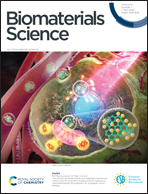Two-photon excitable membrane targeting polyphenolic carbon dots for long-term imaging and pH-responsive chemotherapeutic drug delivery for synergistic tumor therapy†
Abstract
Long-term dynamic tracking of cells with theranostic properties remains challenging due to the difficulty in preparing and delivering drugs by probes. Herein, we developed highly fluorescent one- and two-photon (OP and TP) excitable polyphenolic carbon quantum dots (CQDs) for excellent membrane-targeting and drug delivery properties for synergistic tumor therapy. The green-emissive CQDs (g-CQDs) were synthesized from a three-fold symmetric polyphenolic molecule, phloroglucinol (C3h; symmetry elements: E, C3, C32, σh, S3, and S3−1), in a sulfuric acid medium. Doxorubicin (Dox) was loaded onto the g-CQDs via electrostatic interaction, resulting in a loading efficiency and content of 54.62% and 323.25 μg mL−1, respectively. The g-CQDs@Dox complex exhibited a higher rate of cell killing efficiency at both pH 5.0 and 6.5, with higher reactive oxygen species (ROS) generation due to the greater Dox accumulation in the tumor cells. In addition, TP cell imaging displayed excellent membrane-targeting properties with less photobleaching ability in tumor cells. The in vivo studies confirmed that the g-CQDs@Dox complex has higher affinity towards tumor cells, better inhibitory effects, and an absence of systemic toxicity. Therefore, our developed nanocarrier exhibited better cell imaging, drug delivery, and tumor-targeting properties, and could be used as a “smart” probe for synergistic tumor therapy.



 Please wait while we load your content...
Please wait while we load your content...